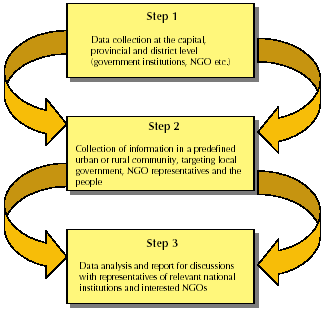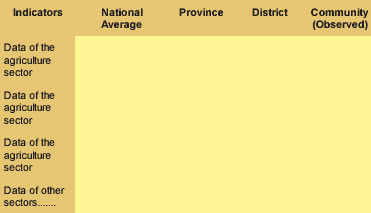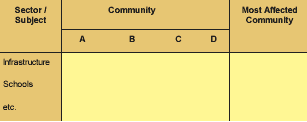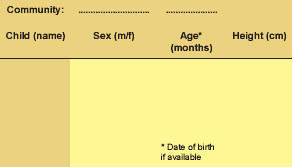Rapid Assessment of Nutrition - RAN - Principles and General Procedures
|
|
The procedures to apply RAN include mainly the review of existing data and the assessment of the perception of the population to be targeted in the future. The analysis of documents or statistics, and the application of qualitative rapid assessment procedures are the predominant tools during project identification. RAN usually takes no more than three weeks and depends on the professional experience, the working conditions, the knowledge on local languages, the capacities of the involved institutions and the experience with participatory and rapid assessment tools. RAN can be applied as a particular methodology, but it can also be part of a general project identification mission. RAN is conceptualised for the systematic assessment of nutrition related information during project identification. The presented methodology serves to guide and orient a project finding mission, collecting data under time pressure and within an unknown context. RAN should therefore be adapted to the local context, e.g. when it is applied in conflict post-war regions or in transformation countries. Figure 1: Three methodological steps of RAN
|
|
|
Step 1: Data collection at the capital, provincial and district level (government institutions, NGOs etc.) Methodology: a) Review of scientific literature, which can provide some poverty oriented cause-effect-relationships for the population in a specific country. b) Review of information gained in governmental offices (Health department, agricultural sector, statistical offices etc.), which provide useful general data on the demographic, health and socio-economic situation at a regional level. c) Review of studies conducted by international organisations (World Bank, World Food Program, International Red Cross, Medecins sans Frontière) and national NGOs (Associations working in the area of public health, nutrition, women’s affairs, watershed management or rural development). The outcomes: a) First Interim Report. b) Suggestions and assumptions, based on the review of the literature and secondary data records, for reflection and study in the rural/ urban areas and communities. Step 2: Collection of information in a predefined urban or rural community, targeting local governments, NGO representatives and the people Methodology: a) Several trips to selected communities should be undertaken to talk with the people in the surveyed area. b) Transects should be made with local government officers and community leaders, through the district or community, in order to observe and compare the secondary data and the verbally commu nicated information with the reality. c) Group discussion should be carried out with local people, to obtain an idea about food habits, beliefs, customs and perceived needs in the sector of food security. d) Measuring the body stature of school children could be a tool if no anthropometric data is available in the region. Measuring the height of children with a simple anthropometric tape can provide important information on chronic malnutrition i. e. if children are too small for their age. This reflects the poor conditions or poverty situation in the communities. The outcomes: a) Second Interim Report, based on the outcome of the talks with local key persons, semi-structured interviews, and question guidelines applied during group discussions in the field. Step 3: Data analysis and report for discussions with representatives of relevant national institutions and interested NGOs Methodology: a) The analysis of the survey forms provides comparable information between communities or geographical areas. b) The analysis of the semi-structured interviews provides complementary information about the perception of the people concerning nutrition and poverty. c) The analysis of the group discussion provides specific topics (problems, ideas, doubts, perceptions, self-assessment of poverty etc.), which could have emerged during the discussion process at community level. d) Cross checking the different sources of information and persons to be involved during project identification helps clarify the understanding of the nutritional and/or poverty situation of the population. Outcomes: a) The final report, including the main findings, hypothesis for the project planning and conceptualisation of areas to be studied in detail, and the general conclusion on the nature of the project (e.g. Integrated Food Security Project, agricultural extension project, community development project, specific nutrition project etc.) Summary The following table presents the elements that need to be scheduled while undertaking a RAN during the project identification stage. The table summarises the previous steps 1-3 into 16 smaller steps. Useful forms for field work Two types of practical forms have been developed to facilitate the application of RAN during project identification:
These forms should be considered as an aid. If necessary, they should be adapted to the specific situation of a survey, and not be considered binding. 1) Analysis Forms (AF) The Analysis Forms are developed for: a) Data comparison of national average, province and district to identify limited resources and problems. b) Partial justification of the pre-selected area for the future project/ program implementation (targeting approach). Table 1: Summary of steps 1-3 |
 |
Note: In general, at the District and Community level, the socioeconomic situation of the population and the supply of resources should be worse than at the national average and province level, to be sure an area with poverty conditions has been selected. Examples of analysis forms have been prepared for fieldwork: a) Seasonality in the surveyed area. b) Data for the agricultural sector. c) Data for the health sector. d) Data for the economic sector. e) Data for the educational sector. f) Demographic data. g) Analysis of anthropometric indices (Based on the data obtained from measuring the body stature of the schoolchildren during RAN). Analysis forms compare the sector related data at the national, provincial and local level, in order to determine the most affected areas. The following table is an example: Table 2: Analysis form comparing sectoral data at different levels
|
 |
2) Survey Forms (SF) The survey forms are provided to: a) Guide the practitioners again on the points considered as important for observation, interview and group discussion. b) Fill in the results of the observation, semi-structured interviews, and group discussions with community members of all communities. c) Visualise the results obtained in all communities, comparing them and identifying weaknesses and strengths. d) Include the available resources and existing habits in the analysis of alternatives. Examples of survey forms have been prepared for fieldwork: a) Infrastructure in the community. b) Living conditions of the visited households. c) Demographic and socio-economic data. d) Health services in the 5 communities. e) Survey Form AGRICULTURE – Cultivation. f) Survey Form AGRICULTURE – Domestic animals. g) Food consumption habits. h) Breastfeeding, supplementary feeding and weaning practices. i) Anthropometric data collected from schoolchildren. j) Analysis of groups and institutions potentially participating in the project. Survey forms compare the obtained data between different communities, e.g. table 3.
Table 3: Survey form comparing obtained data between different communities
Additional information: Measurements of body stature of school children The most reliable way of assessing the nutritional situation of a community is to take the body measurement of the children. Children show body growth failures when they grow up under poor conditions or if they are suffering from food shortage or infectious diseases. These failures in body stature are due to long term nutritional or health problems and can be measured. The relative height for age of a preschool child is internationally recognized as an appropriate indicator for the nutritional problem within a community. Therefore, anthropometric measurements of the first grade in local schools are a good proxy indicator for nutritional problems within the community. Samples should be taken during project identification according to given field conditions and time constraints. The standing body height (stature) of the schoolchild is measured in a standing position. The child should stand without shoes on a level floor and should lean with its back against a wall. The child then draws himself or herself to full stature without raising the shoulders, with hands and arms hanging relaxed, with the feet flat on the ground. The legs and heels should be placed against each other. The buttocks, shoulder blades and head should rest against the wall. The estimated line between the eyes and the auditory passages should be level with the floor. The stature should be measured using a microtoise fixed to the wall (to the nearest 0.1 cm). If a microtoise is not available, a wooden rule or a measuring tape (preferable a tape made out of fibreglass) should be placed against the wall. When measuring stature, the measuring tapes or wooden rules, in which a device is placed on the head when the tape or rule is fixed to a wall should not be used. The scale should commence at 0 cm at the floor. Otherwise, the result can be inaccurate, about 1 cm short. A wooden or metal right angle should be employed in measuring. This instrument is placed lengthwise against the measuring tape on the wall and is pressed gently against the head so that the stature can be read on the measuring tape in cm. Measuring tapes are sometimes calibrated in inches and centimetres on the same side. This can cause confusion during measurement. Table 4: Anthropometric Data Sheet of School children
Presentation of findings The final report of RAN should present all relevant nutritional and poverty related information of the potential target population as listed below: a) Description of the situation by sector (Summary of the analysis forms). b) Description of the situation by region (Summary of the survey forms). c) Description of the situation from the community point of view (Analysis of the group discussions and key interviews in the field). d) Estimation of the situation from the point of view of policy makers (National, regional, and local). e) Results of the anthropometric measurements. f) Preliminary description of the problem tree. g) Proposal for the type of project. h) Proposal for the main project strategies. i) Analysis of alternatives. j) Summary. |





